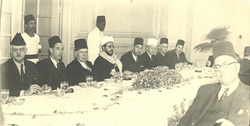History of the Arab League

05/08/1942: Egypt invited Iraq, Trans-Jordan, Saudi Arabia, Syria, Lebanon, and Yemen to send their representatives to exchange views on the issue of unity. A Preparatory Committee, composed of these representatives in addition to a representative of the Arabs of Palestine, held a two-week meeting in Alexandria thus launching what was know as the "Arab Unity Consultations" phase.
07/10/1944: The Arab Unity Consultations led to the signing of hte Alexandria Porotocol by the heads of governments of Egypt, Trans-Jordan, Syria, Iraq and Lebanon. This document included the principles for establishing and managing the organization which will group independent Arab states. These principles were later included in the Charter at a later stage. The signing eremony of the Protocol was held at the Headquarters of hte University fo Alexandria (then Farouk Ist University). The delegations of Saudi Arabia and Yemen deferred signing the Protocol until their governments took note of the text. Saudi Arabia signed the document on 3/1/1945 followed by Yemeen on 5/2/1945.
03/03/1945: "The Political Sub-Committee" established upon the recommendation of the "Alexandria Protocol" concluded its work after holding sixteeen sessions at the office of the Egyptian Ministry of Foreign Affairs in Alexandria. Its members agreed on the text of the "Charter of the League of Arab States" which was mainly based on the "Alexandria Protocol."
22/03/1945: The Heads of Governments of five Arab states, namely: Iraq, Trans-Jordan, Syria, Lebanon and Egypt, signed the final version of the "Charter of the League of Arab States." Saudi Arabia signed the original version at a later stage. The Charter includes twenty articles that define the objectives of the Arab League and the framework of its system of work. The signing ceremony of this historical document took place in the main hall of Al- "Za'faran.
07/10/1944: The Arab Unity Consultations led to the signing of hte Alexandria Porotocol by the heads of governments of Egypt, Trans-Jordan, Syria, Iraq and Lebanon. This document included the principles for establishing and managing the organization which will group independent Arab states. These principles were later included in the Charter at a later stage. The signing eremony of the Protocol was held at the Headquarters of hte University fo Alexandria (then Farouk Ist University). The delegations of Saudi Arabia and Yemen deferred signing the Protocol until their governments took note of the text. Saudi Arabia signed the document on 3/1/1945 followed by Yemeen on 5/2/1945.
03/03/1945: "The Political Sub-Committee" established upon the recommendation of the "Alexandria Protocol" concluded its work after holding sixteeen sessions at the office of the Egyptian Ministry of Foreign Affairs in Alexandria. Its members agreed on the text of the "Charter of the League of Arab States" which was mainly based on the "Alexandria Protocol."
22/03/1945: The Heads of Governments of five Arab states, namely: Iraq, Trans-Jordan, Syria, Lebanon and Egypt, signed the final version of the "Charter of the League of Arab States." Saudi Arabia signed the original version at a later stage. The Charter includes twenty articles that define the objectives of the Arab League and the framework of its system of work. The signing ceremony of this historical document took place in the main hall of Al- "Za'faran.
